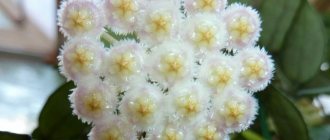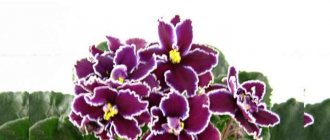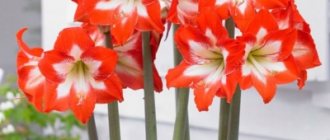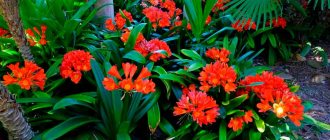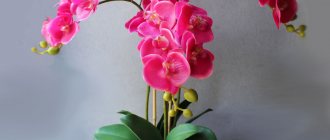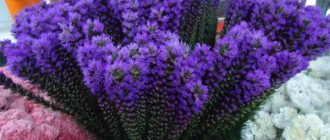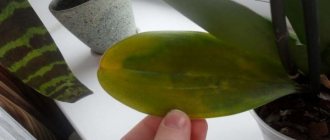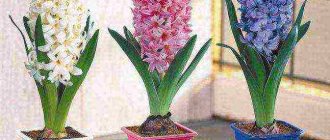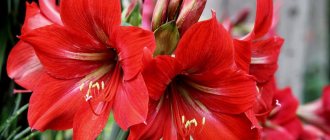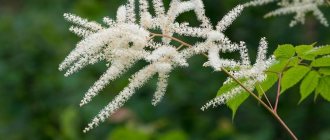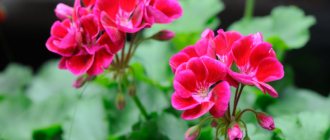Maintenance and care of hipperastrum: how to plant a flower correctly
The flower is propagated mainly by bulbs and children.
During seed propagation, varietal characteristics are not completely transmitted to the offspring. Seedlings bloom in the 3rd–4th year. To obtain seeds, flowers are pollinated artificially. When grown in earthen mixtures, in the summer they are kept in a sunny window or on a balcony, watered and fed abundantly. In August, after the end of growth, watering is gradually reduced, at the end of September dead leaves are cut off, watering is stopped completely and only occasionally (about once a month) water is poured into the pan to prevent the roots from dying off, but the soil in pots with resting bulbs should be touchable dry, not wet. Pots with resting bulbs are kept in a dry and dark place at a temperature of about +7–10 °C. Lower temperatures are harmful to indoor hippeastrums even during the dormant period. In December-February, pots with bulbs are placed in a warm place with a temperature of +20–25 °C (for example, near a stove or central heating radiator) and not watered at all until the flower shoot appears, after which the pots are transferred to a bright window and poured into a tray warm water so that the dried soil is well saturated with it. If the water has cooled down and the top layer of soil in the pot is still dry, replace the cooled water with warm water several times. Until the flower arrow reaches 7–9 cm in height, water very moderately, since otherwise the leaves will grow and the flowers will not develop. Then watering is gradually increased.
30–40 days after flowering, hippeastrums are transplanted into a nutrient mixture composed of leaf, humus and turf soil with an admixture of washed coarse sand (1: 2: 1: 1). With proper cultivation and care, hippeastrums are replanted every 2–3 years. Annual replanting is not necessary, but it is necessary to change the top layer of soil every year. When transplanting, remove the bulbs from the pot, shake off all the old soil from the roots and cut off the rotten roots with a sharp knife. The bulb should sit in the ground no deeper than 2/3 of its height. Transplanted indoor hippeastrums are kept on a bright window in a warm room and watered with warm water. Pots should not be too spacious. It is enough if the distance between the wall and the bulb is 2–3 cm. In a very spacious container, the plant may not bloom for a long time.
A faster way to vegetatively propagate hippeastrum flowers at home is by dividing the bulbs. From one mature bulb you can get up to 40 children. The onion is cut so that each part has a piece of the bottom and scales, the sections are sprinkled with crushed charcoal and the onion slices are placed in boxes with a light peat mixture. After 40–50 days, children are formed, which are planted in pots next spring.
Many gardeners advise planting and caring for hippeastrum in hydroponic culture. It is grown in double flowerpots on a nutrient substrate of expanded clay with sand in a 2:1 ratio using LTA-2 solution. Hydroponic cultivation is not difficult at all. In the autumn-winter period, when the leaves have died, the plant is kept somewhere in a semi-dark place at +7–8 °C in a solution of very low concentration (25–45%), periodically moistening the expanded clay around the inner pot, where some of the roots are also preserved. Since January, flowerpots with bulbs are exposed to light and with the appearance of a flower arrow, the concentration of the nutrient solution is increased to 100%. At this time, it needs good lighting and a temperature of +20–22 °C. After the flower shoot develops, the leaves begin to grow. Strong specimens of hippeastrum at home produce two inflorescences with three huge flowers. Intense, green, erect leaves catch up with the flower arrow in growth. By autumn, the plant gradually enters a dormant period, the leaves die off. After flowering, the children are separated from the mother bulb. Keeping and caring for hippeastrum is possible not only as a potted plant, but also in a winter garden.
Video tutorial on growing hippeastrum
If you provide hippeastrum with proper care, this plant will delight you with magnificent flowering, decorating your home for many years. As you can see, this is not difficult to achieve. We hope our advice will help you achieve what you want. In the comments you can share your experience in growing this flower, leave questions, tips and comments. Good luck to you!
- Author: Svetlana Grishkina
Good afternoon My name is Svetlana. This site has become for me not only an additional source of income, but also an opportunity to share with you my knowledge in housekeeping. Rate this article:
- 5
- 4
- 3
- 2
- 1
(0 votes, average: 0 out of 5)
Share with your friends!
Reproduction of hippeastrum
Reproduction of hippeastrum by children
Hippeastrums reproduce by seeds, by dividing the bulb and by children. It is easier to implement the vegetative method, which preserves all the characteristics of the parent hippeastrum in the new plant. When replanting, well-formed hippeastrum children with developed roots that have reached a diameter of 2 cm are separated from the mother bulb and, after treating the fracture sites with crushed coal, they are planted in separate pots to a depth of 2 cm. For two years, do not cut leaves from young plants even during the dormant period . The daughter bulbs of hippeastrum bloom in the third or fourth year.
Hippeastrum propagation by dividing the bulb
Some varieties of hippeastrum do not produce children, so they are propagated by dividing the bulb. Using a sharp sterile knife, cut the onion into several parts so that each has a part of the bottom with roots. The sections are treated with wood ash or crushed coal, dried for several days, after which the sections are laid out in separate pots with perlite or a mixture of sand and peat so that parts of the bottom with the roots simply lie on the substrate.
You can not cut a large onion into pieces completely, but simply make several deep cuts on it at the same distance from each other, without cutting the bottom. The wounds are treated with charcoal, the bulb is dried for two to three days and placed in a pot on a substrate consisting of perlite or a mixture of peat and sand. Water the bulb through a tray, and after a while, babies form at its base. You already know how to separate and plant them.
Hippeastrum from seeds
Hippeastrum is also propagated by seed, but the disadvantage of generative propagation is that it does not preserve the varietal properties of the parent plant in the offspring, so it makes sense to grow only species-specific hippeastrum from seeds.
Hippeastrum seeds should be sown immediately after they ripen, when they have almost one hundred percent germination. They are embedded in the soil to a depth of 1 cm, watered, covered with film and the crops are placed in a warm place. The seedlings will appear in 2-3 weeks, and as soon as this happens, you will need to immediately remove the covering and place the seedlings in the brightest place under bright but diffused light. Grown seedlings are planted in separate cups and, as they grow and develop, they are fed with a weak solution of mineral fertilizer for deciduous plants. Young plants do not need a rest period.
Landing conditions
Hippeastrum is planted in such a container that there is a gap of at least 2 cm between the planting material and its walls, preferably more - up to 4-5 cm. The container should be high and narrow, with drainage holes. The material from which the pot is made is not particularly important, but more often hippeastrum is planted in plastic containers. Ceramics tend to get very hot in the sun, which has a bad effect on the plant bulbs.
The ideal soil composition is:
- two parts perlite, it can be replaced with coarse sand;
- humus – 1 part;
- leaf and turf additive.
In order to improve water and air permeability, vermiculite can be added. If the seedling is transplanted, there should be a lot of water and it should penetrate well. It is important that the soil meets the following requirements:
- was light;
- loose;
- It allowed water and air to pass through well, otherwise the plant would die from stagnation of moisture.
Benefits and harms for humans
It is worth remembering that the juice of the bulbs is poisonous, so all manipulations are carried out with gloves. Do not allow juice to come into contact with mucous membranes and skin. When working without gloves, upon completion, you should immediately wash your hands with soap.
Amazing properties are attributed to hippeastrum. It is believed that this flower is conducive to fantasy, so it is simply necessary for writers. The plant is also beneficial in kindergartens, supporting the creative thinking of children. Naturally, they put it in places inaccessible to children. It is not recommended to place hippeastrum at work, unless it is associated with creativity.
Photo of what hippeastrum looks like
A photo of hippeastrum attracts the attention of flower growers. The beauty of the flowers fascinates with their original shape, combined with unusual colors of various shades. Growing hippeastrum is a simple, interesting process. It is important to follow agricultural techniques and basic care rules. Then an exotic flower will effectively decorate any inconspicuous corner in the room, give the interior a lively color, make it more comfortable and beautiful.
Diseases and pests of garden and indoor flowers
Even if the plant is not planted in open ground for the summer, it can get sick or acquire pests even in indoor conditions. Most often, hippeastrums are susceptible to diseases such as red burn fungus, downy mildew and red rot. The disease can be determined by the appearance of the flower:
- the leaves and bulb are covered with red spots - a fungal burn;
- a white coating appeared on the leaves - powdery mildew;
- withered leaves and the formation of putrefactive discharge on the bulb is rot.
Red burn of hippeastrum
Rot is removed as follows:
- carefully examine the flower and the underground part, remove the affected areas;
- leave the bulb alone for several hours, allowing it to dry;
- prepare new soil:
- Before planting, the bulb is treated with a solution of Fundazol.
Special preparations that can be purchased at flower shops will help you get rid of powdery mildew. To get rid of the red burn, dig up the bulb and trim off all affected areas. The cut areas are treated with a mixture of copper sulfate and chalk (1:20). The bulb is left in this form for a week, after which it is planted in new soil. It is advisable to treat the soil with a suitable fungicide before planting.
The most common pests of indoor hippeastrum are scale insects, spider mites, aphids and scale insects. You can get rid of them using special insecticides.
Diseases and insects can be the main reason why hippeastrum does not bloom. It is necessary to promptly detect pests and diseases that can harm this beautiful plant.
It will also be interesting: Vallota - care at home and types of indoor plants?
Hyperastrum flowering
This popular perennial is valued for its unusually beautiful and massive inflorescences. But it is difficult to achieve flowering indoors, since the flower comes from the tropics, which is why it is capricious and demanding to care for.
Young specimens are able to bloom once a year, and older ones - 2 times. The bulb produces several powerful flower stalks, each of which produces from 2 to 7 flowers, which are odorless, but their flowering period is 2-4 weeks.
On a note! The timing of flowering can be adjusted to coincide with certain dates - this is beneficial, since a flowering perennial is a gorgeous gift that can replace expensive exquisite bouquets.
Caring for hippeastrum at home
How to care for hippeastrum
The indoor hippeastrum flower needs good lighting, so it is preferable to keep it on southern, southwestern and southeastern windowsills, provided that direct sunlight does not fall on the plant during the midday hours. In order for the flower to remain compact and slender, it needs to be rotated around its axis from time to time. In the warm season, hippeastrum is comfortable at a temperature of 17-25 ºC, but it will be even better if you place it in the garden, on a terrace or balcony, while protecting it from drafts and too bright sun.
Growing hippeastrum involves regular application of fertilizers to the substrate. They feed homemade hippeastrum twice a month from the beginning of the period of active growth with a solution of mineral fertilizers for deciduous plants, and when the flower has leaves, they switch to fertilizers for flowering indoor plants, watering the soil in the pot with them in the same mode. The concentration of the solution should not be too strong, otherwise you may burn the roots of the plant. When the hippeastrum flower shoot reaches 12-15 cm, water it with a pale pink solution of potassium permanganate, and after a few days add phosphorus fertilizer to the soil.
Watering hippeastrum
At the beginning of the growing season, after the hippeastrum leaves the dormant period, watering is carried out very moderately, even meagerly, but gradually the water consumption and frequency of watering are increased: the hippeastrum in the pot should not feel thirsty, especially during the period of formation of the peduncle and the appearance of buds. As soon as the flower arrow reaches a height of 7-8 cm, the substrate must be kept slightly moist at all times: blooming hippeastrum really needs moisture. To prevent water from getting on the bulb, it is better to moisten the soil using the method of bottom watering: settled water at room temperature is poured into a tray under the pot until the entire earthen lump of the hippeastrum is wet. When the dormant period begins, watering is gradually reduced until it stops completely.
Hippeastrum transplantation
There is no need to torment indoor hippeastrum with annual transplants. It is enough to transfer it from a pot that has become cramped to a new one, 2-3 cm larger in diameter, once every 3-4 years. Hippeastrum is planted in a new pot after flowering or after a dormant period. The container for the plant is chosen to be narrow and high: between the bulb and the walls of the pot there should be a layer of earth no more than 2 cm thick. Hippeastrum needs soil with approximately the following composition: one part each of humus, sand and peat and two parts of turf soil. Or: one part humus, and two parts each of leaf soil, perlite (coarse sand) and turf soil. Be sure to place a thick layer of drainage material at the bottom of the vessel. After transshipment of the hippeastrum and filling the space in the pot with soil mixture, the plant bulb should look out from the substrate by at least a third of its body. If you do not intend to replant the plant in any season, change the top layer of substrate 5 cm thick in the pot.
Hippeastrum after flowering
In order for a plant to bloom every year, it must rest fully. The dormant period of hippeastrum usually lasts from the end of summer to the end of October. After the leaves have completely dried out, during which watering is gradually reduced and fertilizing of the plant is stopped completely, you need to remove the wilted leaves, cut off the stem, transfer the hippeastrum to a dark, dry room with a temperature no higher than 10-12 ºC, put the pot with the bulb on its side and leave without watering for 6-8 weeks. After this period, the flower is returned to its usual place, they begin to water it little by little and resume feeding.
Some hobbyists grow hippeastrum without allowing it to rest. They keep it in a warm room all year round, water it and fertilize it. However, neither a person nor a plant can do without rest and sleep for a long time, so be prepared for the fact that one day, despite all your worries, the hippeastrum will stop blooming.
Hyperastrum transplant
Adult plants need to be replanted twice a year, young plants – annually. It is better to carry out the procedure:
- before the bulbs enter the dormant stage;
- at the first signs of growth after the plant has been dormant;
- before throwing out the arrow with buds;
- upon completion of flowering and removal of the arrow.
On a note! It is recommended to replant the plants immediately after purchase, since the pot and old soil will negatively affect the development of the flower and will not bring a positive result.
When growing, you should update the top layer of the substrate once a year. The favorable time for this procedure is spring.
Step-by-step guide to hippeastrum transplantation:
- Take a low but wide pot a few centimeters larger than the previous one.
- Place drainage made of expanded clay or crushed brick at the bottom of the container and fill it with soil mixture, which you can buy at a garden center or make yourself by combining turf soil, leaf soil, humus and sand in equal proportions.
- Remove the onion, peel it from dry scales to fleshy and dense white tissue. This will rid the planting material of pathogenic microorganisms and activate development.
- Make sure the roots are healthy, it is important to remove dry and damaged ones.
- Place the prepared bulbs in a non-concentrated solution of potassium permanganate for 30 minutes and dry.
- If children have formed on the roots, they should be removed so that they do not subsequently take away the strength and energy from the parent bulb.
- Plant the planting material so that it protrudes 1/3 above the ground surface.
- Compact the substrate around the bulb and moisten the soil.
After transplantation, the flower must be placed in a well-lit, warm room.
Caring for hippeastrum at home
Proper care of home hippeastrum includes the creation of certain conditions: temperature, light level, room humidity. These indicators may vary depending on the phase of flower development. The decorative beauty of each plant will depend on proper care.
Lighting
The light-loving plant will feel comfortable on the southeast, south or southwest side of the house. In the wild, the flower grows in the steppes, so it is not afraid of direct sunlight. It can be placed both under direct rays and in a room with diffused light. On very hot days, it is advisable to shade the flower from the excessively scorching sun. Hybrid bulbs that shed their leaves during the dormant period can be placed in a cool, dark place.
Temperature
Low temperatures (below 5 ˚С) have a bad effect on the formation of peduncles. During the dormant period, the bulb is able to survive a short-term drop in temperature to -1 °C.
Sudden temperature changes have a bad effect on flower development.
Optimal temperature for the plant:
- during daylight hours – 20-22 ˚С;
- in the dark - not less than 18 ˚С.
The maximum permissible humidity level in the environment is 80%. High humidity can cause disease and even death of the plant. You should not spray the leaves; it is better to sometimes wipe them from dust with a damp cloth.
How to water and feed correctly
Proper watering for a flower is very important, because at different times it needs a certain amount of moisture. At the first signs of hibernation, watering is completely excluded. You can add a little water to the pan for vital processes in the bulb. After waking up, they begin to water moderately and quite rarely - once every two weeks.
During the formation of the peduncle, water the flower regularly, while adhering to the following recommendations:
- water for irrigation should be at room temperature;
- the soil should not be excessively wet;
- The soil should dry out between waterings;
- Do not let liquid get on the bulb.
In the wild, hippeastrum blooms only during the rainy season, and during drought the bulbs rest. Therefore, the frequency of watering should imitate natural conditions.
The plant needs high-quality and timely feeding. Fertilize should be done once every ten days. During the dormant period, the flower is not fed. The composition of fertilizers depends on the stage of flower development:
- The beginning of growth requires nitrogen-potassium fertilizers.
- For the full formation of a peduncle, fertilizing is applied, which contains potassium, nitrogen and phosphorus.
- During the flowering phase, they are fed with phosphorus-potassium complexes.
The first fertilizing is applied after the flower shoot reaches a height of 10-15 cm.
Soil and pot
To make it easier for the flower to absorb nutrients, the filler in the pot should be light and loose and have excellent moisture and water permeability. Experienced flower growers advise preparing a substrate from the following components: peat, deciduous soil and river sand. You can purchase ready-made filler at a flower shop. Begonia soil will be an excellent soil for a flower.
Sometimes ash or compost is added to the soil.
To grow this variety, you should purchase a narrow and tall flowerpot. This is due to the rather long roots of the plant, which feed the bulb even in the dormant phase. Choose a pot that is not too spacious: the distance between the pot and the bulbs should not exceed 2 cm.
Preparation for winter and rest period
The dormant period lasts from September to January. If the flower was planted in open ground for the summer season, then with the arrival of autumn it should be moved to the apartment. Watering the flower is gradually reduced, the leaves begin to dry out. After the leaves and stems are completely dry, the stem is removed and the bulb is placed in a dark place.
The flowerpot is moved on its side and left at a temperature of 10-12˚C for 6-8 weeks.
The flower can do without the dormant stage. To do this, it must be under bright light throughout the year, in a warm room, and regularly receive fertilizer and watering. With this mode, the flower can bloom in mid-autumn or mid-spring. Rich green foliage remains attractive all year round.
It will also be interesting: Amaryllis - flower care at home, planting and growing?
Reviews about growing hippeastrum
I don’t understand this plant, it’s almost a miserable year from the bulb, happiness is if two or three leaves stick out, no aesthetic pleasure to shoot out the arrow once a year and bloom. The flower, of course, is gorgeous and beautiful, but I had to wait so long... I gave it up.
Marina
https://floristics.info/ru/komnatnye-rasteniya/semejstva/amarillisovye/1769-gippeastrum.html
I have only three hippeastrums - I really like the flower, but I couldn’t get used to caring for it: sometimes they don’t go to sleep, sometimes, on the contrary, I’m waiting for flowering, and the plant turns yellow leaves and goes into hibernation, so I didn’t expand the collection. This year we were doing renovations, I took the plants out into the garden in the spring and forgot about them - the bulbs had grown huge powerful rosettes, one hippopotamus is about to bloom, and the second one has produced three arrows, I’m waiting for what “surprise” the third plant will produce.
Zosia
https://floristics.info/ru/komnatnye-rasteniya/semejstva/amarillisovye/1769-gippeastrum.html
This winter I “dabbled” with hippeastrum pollen for the first time. Pollinated Red Lion with pollen from Lemon Lime, Susane and Exotic Peacock. The seeds ripened for about a month. By the way, Susane froze the pollen because there was no candidate for pollination. The hippeastrum seeds seemed somehow flat. Well, I think the first damn thing is lumpy. And I sowed all the seeds from the box very densely in one bowl. Three pollinations - three bowls. Joy knew no bounds when, ten days later, friendly shoots began to appear. Happened!!!
Lucia
https://frauflora.ru/viewtopic.php?t=7854
I make mine bloom like this: I put it off the windowsill on a shelf, away from the window. I water literally a drop a week so that the bulb does not dry out. If the apartment is humid, then you don’t have to water it. And after 2 weeks it sheds all its leaves and shoots an arrow. Then we start watering. After the first arrow, a second one always appears for me, and 4 flowers bloom at once.
ila3
https://otzovik.com/review_1910792.html
Signs and superstitions
Hippeastrum can be found in many parts of the world. That is why a large number of signs and superstitions are associated with it. Here are some of them:
- Hypeastrum can relieve bad mood, relieve depression and fatigue, improve friendships and love relationships, and reduce irritability.
- This flower helps to realize creative abilities and is appropriate in the home of writers and artists.
- Hippeastrum is the flower of desires. Say the cherished words over the pot with the plant and wait for the result.
- Among the negative qualities of the plant, it should be noted its ability to absorb negative energy. Therefore, under no circumstances should you quarrel near a bush.
- When an unwanted guest appears in the house, you can find out his intentions. Just ask him to touch the petals and watch the plant's reaction after leaving. If the flower begins to fade, it means the guest came with malicious intent.
- If a girl is not sure of the love of her chosen one, there is such a sign: you need to ask your partner to give a hippeastrum flower and grow the plant. When leaves or a flower arrow appear, one can speak of the sincerity of feelings.
- Hippeastrum gives confidence and determination to individuals with weak energy, helps to find harmony and mental balance.
- During flowering, place the pot in the center of the room and your home will be filled with positive energy.
- This flower is recommended for single men who want romantic encounters. To do this, you need to plant the hippeastrum in a pot yourself and success with the opposite sex is guaranteed.
In order for the hippeastrum to feel good, it is necessary to provide it with proper care at home. This is not difficult to do, following the recommendations described in the article.
Problems during cultivation
With insufficient watering, the leaves turn pale and the flowers tilt their heads. During flowering, it is recommended to keep the soil slightly moist. At low temperatures, the flowers begin to turn black. It is necessary to move the plant to a warm place. If the leaves become dull and wither, this means that there is excess moisture in the pot. It is recommended to reduce watering, first allowing the soil to dry. If the flowers become dim, you need to shade them from the sun's rays
The leaves of the hippeastrum turn yellow and also dry out in anticipation of a period of rest. If this happens at other times, then pay attention to non-compliance with care recommendations (damp or cold). Examine the plant to see if there are any parasites that can cause yellowing of the leaves.
With proper care and compliance with the watering and fertilizing system, hippeastrum (photo above) will delight you with its beautiful flowering from year to year.
Rest period
If the foliage of the plant turns yellow and the bulbs increase in volume, then this is a signal that the perennial is preparing for a dormant period. At this point, it is recommended to eliminate the leaves, reduce watering, finish fertilizing and move the crop to an unlit room with a temperature of +10-+15°C.
Plants are dormant from September to early January. During this period, the bulb should not be allowed to dry out. To do this, add water to the pan once a month. If you create comfortable conditions for hippeastrum during the dormant period, then next year it will surprise you with luxurious flowering.
Reproduction of hippeastrum
If you follow the rules of care and storage of the bulb, the flower can be grown for more than 10 years. In addition, several methods of propagating hippeastrum are available at home. The perennial is grown from seeds and propagated by dividing the bulb or its children. The last two methods are simpler and faster.
Propagation by seeds
It is better to sow seeds immediately after collection, as they lose their viability
To obtain hippeastrum seeds, the flowers need to be pollinated. This experiment is best carried out in open ground. After the plant has flowered, the seeds ripen in the box within two months. This process will be speeded up by spraying the flower with a 5% boric acid solution. Since the seeds quickly lose their viability, it is recommended to sow them immediately after collection. For this:
- wrap the seeds in a wet rag, place them in a container, cover with glass and leave in a warm place for 10 days - this soaking will help speed up germination;
- the hatched seeds are embedded in a mixture of deciduous soil, sand and peat to a depth of about 2 cm;
- Shoots appear in 2-3 weeks. They require a lot of light, at the same time the seedlings need to be shaded from direct sunlight;
- when two true leaves are formed, the plants are planted in separate 7-centimeter pots;
- Seedlings are watered moderately and fertilized with mineral fertilizers until mid-August.
For the first two years, young plants do not need periods of rest. At the age of three to four years, when the bulb reaches a size of 5 cm in diameter, you can begin forcing the plant. To do this, watering is reduced in August and stopped completely in September. At the end of winter - beginning of spring, you can expect the first flowering of hippeastrum.
Reproduction by children
When propagated by children, flowering can be achieved after 3 years.
In order to fully preserve varietal characteristics, the most decoratively valuable hybrids are propagated by separating daughter bulbs. The size of the bulbs is at least 2 cm, they must be well formed and have their own roots. The babies are separated during transplantation.
Children's education can be stimulated. For this purpose, the bulb is deeply cut into 2-4 lobes. The sections are treated with charcoal powder and left to air dry for several days. After this, the bulb is placed in a sand-peat mixture, the substrate is moistened only through a tray. After some time, daughter bulbs form at the base.
The reproduction process is carried out in the following sequence:
- children are planted in a container with a nutrient mixture to a depth of 3-4 cm;
- in the first two years, plantings are kept in a well-lit place;
- Watering is moderate; in winter, its frequency is reduced.
In the third year, the plants are transplanted into separate pots. Caring for them is the same as for adult hippeastrum. Reproduction by children ensures flowering in three to four years.
Propagation by dividing the bulb
There are times when plants cannot produce children. The solution is to reproduce by dividing the bulb. For this:
- the onion is cut into 4-8 parts, each of which should have a bottom and roots;
- the sections are treated with crushed charcoal and dried for 2-3 days;
- planting material is placed in a nutrient mixture of turf soil, sand and peat.
The soil is kept moist, the air temperature is at +23...+25°C. When young plants begin to sprout from the bulbs, they are planted in separate pots and given the usual care.
Features of the variety
It is best to propagate a perennial plant using the bulbous method; the bulbs are round or cone-shaped. They have short thick stems and scales. According to its parameters, planting material can be 5-10 cm in the transverse section, and the dimensions will depend on the type of flower. At the base of the bulb there are cord-like roots collected in a bunch.
The leaves of hippeastrum are linear with a grooved surface, grow up to 50-70 cm in length, 4-5 cm in width. Their color is often green, less often with a purple tint.
The inflorescences are in the form of umbrellas, each of them contains from 2 to a maximum of 6 flowers. Their length corresponds to 13-15 cm, and the flower diameter on average reaches 25 cm. The flower, located on an elongated petiole, has a tubular or funnel-shaped appearance.
The shade of flowers varies, the main colors are:
- darkish purple;
- scarlet;
- orange color;
- pale and bright pink;
- snow-white.
The fruits of the plant are in the form of boxes, they can have the shape of a ball, corners or be tricuspid, containing seeds inside. They sprout in almost 100% of cases.
Pests and diseases of hippeastrum
Diseases of the hipperastrum
A dangerous disease that can affect hippeastrum is staganosporosis, or red burn of the bulbs. As soon as you find red streaks or dots on the bulb, you need to immediately cut them all out to healthy tissue. Inspect the roots of the hippeastrum and remove those that have died, cut off all leaves with signs of damage. All sections must be treated with Fundazol, Maxim or Fitosporin-M. Dry the bulb for a week and after making sure that there are no new lesions, plant it in a new pot with fresh substrate so that only the roots are in the ground: this will make it easier for you to monitor the condition of the bulb in the future. The first 2-3 weeks after transplantation, watering the hippeastrum is carried out through a tray with solutions of the listed fungicides. Once you are sure that the plant is no longer in danger, you can add some soil to the pot to cover the bottom of the bulb.
Hippeastrum at home can also be affected by fungal diseases anthracnose and fusarium. The plant is treated for these diseases in the same way and with the same fungicides as the red burn: the damaged areas are removed, the cuts are treated with Maxim, Fundazol or Fitosporin-M, the hippeastrum is transplanted into a new pot with fresh substrate and the tray is watered with fungicide solutions.
Hippeastrum pests
Hippeastrums can suffer from pests such as mealybugs, scale insects, onion and spider mites. Those pests that can be seen with the naked eye must be removed from the plant with a cotton pad soaked in alcohol or soap solution. Insects are removed from hard-to-reach places using an ear stick. After this procedure, the flower must be treated with an insecticide solution. In the case of mites, which are not insects, but arachnids, acaricides or insectoacaricides - Actellik, Karbofos or Fitoverm - are used to treat the plant leaves. Most likely, you won’t be able to cope with the problem with one treatment, and you will have to spray the hippeastrum 3-4 times.
Why does hippeastrum not bloom?
Sometimes hippeastrum refuses to bloom at the appointed time, and readers ask how this can be explained. There may be several reasons:
- deficiency of nutrients in the soil;
- lack of strength due to illness, pest infestation or insufficient rest;
- rotting of the bulb due to waterlogging of the soil.
In order to make hippeastrum bloom, there are several tricks:
- before planting, the bulb is kept for three hours in water at a temperature of 43-45 ºC;
- provide the plant with a full period of rest;
- in July, you need to cut off all the leaves of the hippeastrum, deprive it of water for a month, and then moisten it through a tray, and then add a solution of complex fertilizer to the soil. In a month and a half, the hippeastrum will bloom.
What difficulties might you encounter?
Many novice flower growers complain that even with careful care, the flower gets sick. Indeed, the presence of diseases and pests cannot be ruled out.
Among the most common pests are:
- powdery mildew;
- scale insect;
- aphids;
- spider mite.
Their presence will be indicated by a characteristic coating on the leaves of the plant, or other changes.
In addition, bulbous species are often subject to fungal infections and rot. This can be avoided. It is enough to control the level of soil moisture. And before planting, treat the bulbous part with a solution of foundation. The soil is watered with fungicides.
